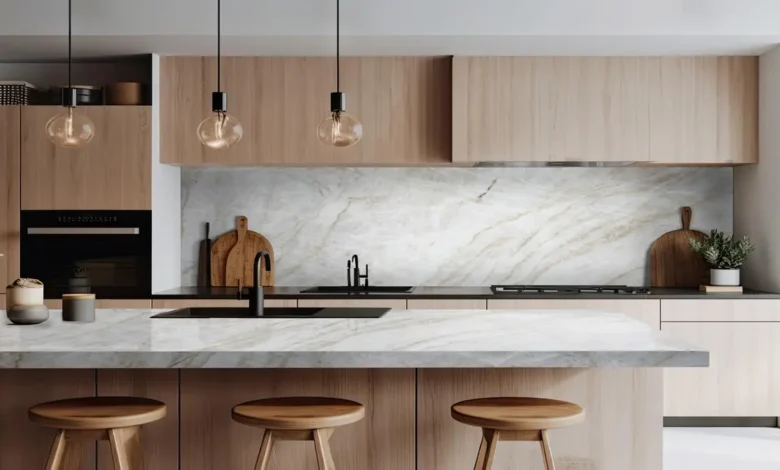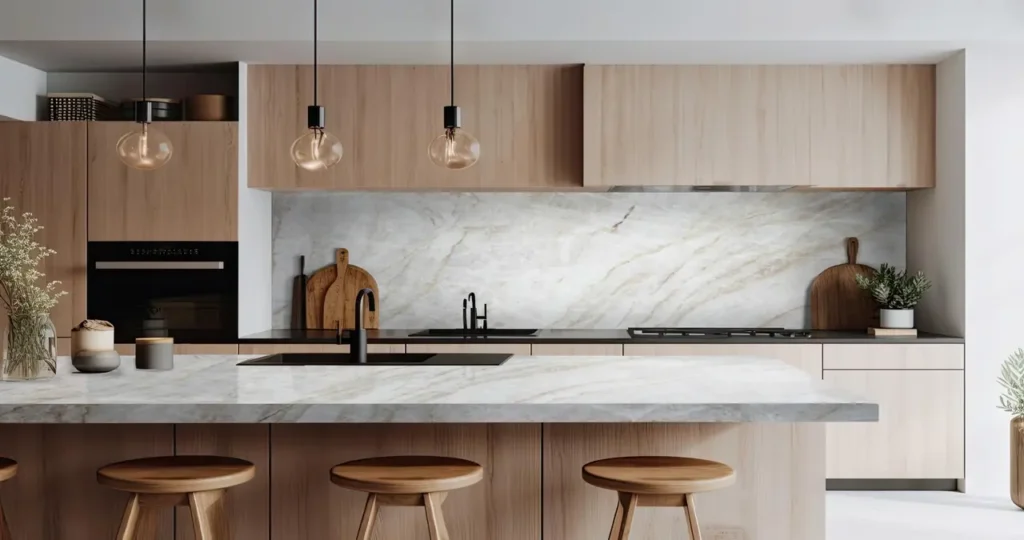Taj Mahal Quartzite: The Elegant Beauty of Natural Stone1

Taj Mahal Quartzite is an elegant, timeless, and sophisticated natural stone that has been gaining popularity in the world of interior design and architecture. Known for its distinctive, luxurious appeal, this stunning material is often used in a variety of applications, from kitchen countertops and bathroom vanities to flooring and wall cladding. Its striking appearance and durability make it a standout choice for those looking to elevate the aesthetics of their spaces.
In this article, we will explore the unique qualities of the Taj Mahal Quartzite, its origin, characteristics, benefits, and various uses in modern design. Whether you’re considering it for your next home renovation or simply curious about this beautiful stone, keep reading to learn everything you need to know about Taj Mahal Quartzite.
What is the Taj Mahal Quartzite?
Taj Mahal Quartzite is a type of natural stone formed from sandstone through a process known as metamorphism. Over millions of years, intense pressure and heat transform the sandstone into a hard, durable stone. This transformation gives the taj its signature appearance, which includes soft, creamy colors with subtle veining in tones of beige, gray, and gold.
One of the key features that sets the apart from other types of natural stone is its appearance. While it may resemble marble due to its soft hues and veins, quartzite is much more durable and resistant to scratching, staining, and heat. This makes it an ideal choice for high-traffic areas and surfaces that are prone to wear and tear, such as countertops and flooring.
The Origins and Formation of Taj Mahal Quartzite
Taj Mahal Quartzite is primarily sourced from quarries in Brazil, where the stone is mined for its remarkable beauty and exceptional quality. The process begins with the extraction of sandstone, which is then subjected to heat and pressure over millions of years. During this time, the minerals in the sandstone undergo a metamorphic change, creating a much harder and more durable stone.
The natural veining and coloration of the are a result of the minerals within the stone. Iron oxide, clay, and other minerals give the stone its characteristic golden veins and soft shades. The unique patterns and colors can vary from slab to slab, ensuring that each piece of it is one of a kind.
The Unique Aesthetic Appeal of Taj Mahal Quartzite
One of the main reasons it has become so popular in interior design is its unique aesthetic appeal. The stone’s soft, neutral tones make it an excellent choice for a variety of design styles, from traditional to contemporary.
The creamy beige, off-white, and light gray hues offer a subtle elegance, creating a serene and inviting atmosphere. The natural veining throughout the stone adds depth and visual interest, while the golden undertones bring warmth and richness to any space. Whether you’re looking to create a tranquil bathroom retreat or a stylish kitchen, the adds an understated beauty that complements a wide range of design palettes.
The Durability of Taj Mahal Quartzite
In addition to its stunning appearance, it is also highly durable, making it an excellent choice for surfaces that are subjected to daily wear and tear. Unlike marble, which is known for being relatively soft and prone to scratching and staining, quartzite is incredibly hard and resistant to damage. This makes it an ideal material for kitchen countertops, bathroom vanities, and even flooring.
The stone’s high resistance to heat means you can place hot pots and pans directly on a Taj Mahal Quartzite countertop without worrying about causing damage. It also resists scratching better than many other natural stones, making it a practical choice for high-traffic areas. When properly sealed, the is also resistant to staining, ensuring that your surfaces remain looking beautiful for years to come.
Comparing Taj Mahal Quartzite to Other Stones
When considering Taj Mahal Quartzite for your project, it’s important to understand how it compares to other popular natural stones, such as marble, granite, and quartz. Each of these materials has its own set of advantages and disadvantages, so it’s essential to choose the one that best fits your needs and style preferences.
- Taj Mahal Quartzite vs. Marble: While both materials have a luxurious, elegant appearance, marble is much softer and more prone to scratching and staining. Taj Mahal Quartzite, on the other hand, is much harder and more durable, making it a better choice for high-traffic areas and surfaces that need to withstand daily use. Marble is also more porous, requiring more maintenance and sealing over time.
- Taj Mahal Quartzite vs. Granite: Granite is another popular natural stone that is known for its durability and variety of colors and patterns. While granite is hard and resistant to scratches, Taj Mahal Quartzite has a softer, more elegant look with softer veining and lighter tones. Additionally, Taj Mahal Quartzite is less likely to absorb stains compared to granite, particularly when sealed properly.
- Taj Mahal Quartzite vs. Quartz: Quartz is an engineered stone that is made from a blend of natural quartz crystals and resin. While it is highly durable and low-maintenance, quartz lacks the natural beauty and variation found in natural stones like Taj Mahal Quartzite. Quartz is also less heat-resistant compared to quartzite, making it less suitable for high-temperature areas like kitchen countertops.
Applications of Taj Mahal Quartzite in Interior Design
Taj Mahal Quartzite’s versatility makes it suitable for a wide range of applications in interior design. Whether you’re renovating a single room or designing an entire home, this natural stone can be used in a variety of ways to elevate your space. Here are some of the most common applications of Taj Mahal Quartzite:
Kitchen Countertops
Taj Mahal Quartzite is an excellent choice for kitchen countertops, where durability and style are essential. The stone’s resistance to heat, scratches, and stains makes it perfect for high-traffic cooking areas. Its elegant, neutral colors can complement a variety of kitchen styles, from modern to rustic. Whether you prefer a polished or honed finish, Taj Mahal Quartzite will add a touch of sophistication to your kitchen.
Bathroom Vanities
In bathrooms, Taj Mahal Quartzite can be used to create stunning vanities that are both practical and beautiful. The stone’s resistance to moisture and staining makes it ideal for bathroom surfaces, while its natural veining adds a touch of luxury. Whether you have a contemporary or traditional bathroom design, Taj Mahal Quartzite will enhance the space with its refined appearance.
Flooring
Taj Mahal Quartzite is a great option for flooring, especially in areas where durability is a priority. Its hardness and resistance to scratching make it a practical choice for high-traffic areas like hallways and living rooms. The stone’s soft tones and subtle veining add a sophisticated touch to any room, creating a beautiful and timeless look that will never go out of style.
Wall Cladding and Backsplashes
Taj Mahal Quartzite can also be used for wall cladding and backsplashes, adding visual interest and texture to your space. Whether you’re looking to create an accent wall or a striking kitchen backsplash, Taj Taj Mahal Quartzite elegant veining and colors will make a bold statement. Its natural beauty will transform any room into a luxurious and inviting environment.

Maintenance and Care for Taj Mahal Quartzite
While Taj Mahal Quartzite is incredibly durable, it does require some maintenance to ensure it stays looking its best. Like all natural stones, it is important to properly seal Taj Mahal Quartzite to protect it from stains and moisture. Sealing helps create a barrier that prevents liquids from being absorbed into the stone, making it easier to clean and maintain.
Regular cleaning with a mild soap and water solution is recommended to keep the Taj Mahal Quartzite looking beautiful. Avoid using harsh chemicals or abrasive cleaners, as these can damage the stone’s surface. Additionally, it’s a good idea to clean up spills promptly, especially those containing acidic substances like lemon juice or vinegar, as these can etch the surface if left untreated.
The Cost of Taj Mahal Quartzite
The cost of Taj Mahal Quartzite can vary depending on factors such as the quality of the stone, the size of the slabs, and the location where it is purchased. On average, Taj Mahal Quartzite is considered to be a mid-to-high-range material in terms of price. While it may be more expensive than granite or quartz, its durability, beauty, and timeless appeal make it a worthwhile investment for many homeowners and designers.
Keep in mind that the cost of installation is an additional factor to consider. Professional installation is recommended to ensure the stone is properly cut, sealed, and installed. Labor costs can vary depending on your location, so it’s important to get quotes from multiple contractors to find the best deal.
Conclusion
Taj Mahal Quartzite is a stunning natural stone that offers a perfect blend of beauty, durability, and versatility. Whether you’re using it for kitchen countertops, bathroom vanities, or flooring, this elegant material is sure to elevate the look of any space. Its soft, neutral colors and unique veining make it a timeless choice for both traditional and modern design styles.
With proper care and maintenance, the Taj Mahal Quartzite can last for many years, retaining its beauty and functionality. If you’re looking for a luxurious and durable natural stone that will stand the test of time, Taj Mahal Quartzite is a fantastic option that won’t disappoint.
Whether you’re embarking on a new construction project or renovating your existing home, this stunning stone will add elegance and sophistication to your interiors.



